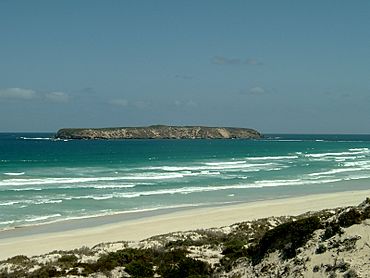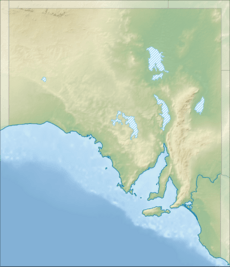Whidbey Isles Conservation Park facts for kids
Quick facts for kids Whidbey Isles Conservation ParkSouth Australia |
|
|---|---|
|
IUCN Category Ia (Strict Nature Reserve)
|
|

Golden Island seen from Almonta Beach
|
|
| Nearest town or city | Coffin Bay |
| Established | 16 March 1967 |
| Area | 2.48 km2 (1.0 sq mi) |
| Managing authorities | Department for Environment and Water |
| See also | Protected areas of South Australia |
The Whidbey Isles Conservation Park is a special protected area in South Australia. It's made up of seven islands found about 15 kilometers (9 miles) west-southwest of Coffin Bay on the lower Eyre Peninsula. These islands are a safe home for many amazing animals and plants.
Contents
What are the Whidbey Isles?
The Whidbey Isles Conservation Park includes almost all the islands in the Whidbey Isles group. This includes the Four Hummocks group, Perforated Island, Price Island, and Golden Island. There's one small exception: the most southern island in the Four Hummocks group. This island has a lighthouse and is managed by the Australian government, so it's not part of the park.
These islands are quite rugged and beautiful. Some of the islands closer to the coast are made of limestone. They are flat with steep, rocky coastlines and have low shrubs growing on them. The islands further out, like the Four Hummocks, are made of granite and have grassy tops.
History of the Park
The land that makes up the Whidbey Isles Conservation Park was first protected on March 16, 1967. It was called a "Fauna Conservation Reserve" back then, meaning it was set aside to protect animals.
Later, on April 27, 1972, this reserve officially became the Whidbey Isles Conservation Park. This happened under a new law called the National Parks and Wildlife Act 1972. On December 19, 1991, even more land was added to the park. This new area included the land between the high tide and low tide marks, giving even more protection to the coastal environment. As of 2019, the park covers an area of 2.48 square kilometers (about 1 square mile).
Amazing Animals of the Isles
The Whidbey Isles are very important because they are a breeding ground for many seabirds and marine mammals. This means these animals come to the islands to have their babies and raise their young.
- Australian Sea-lions: You can find colonies of the endangered Australian Sea-lion (Neophoca cinerea) here. These are special because they are one of the rarest sea-lion species in the world.
- New Zealand Fur-seals: The protected New Zealand Fur-seal (Arctocephalus forsteri) also has colonies on some of these islands.
- Seabirds: The islands are home to many different seabirds. You might see breeding populations of short-tailed shearwaters, fairy penguins, and rock parrots.
- Birds of Prey: Larger birds like the white-breasted sea-eagle and osprey are also known to use the islands for hunting and nesting.
The islands are in excellent condition because there are no introduced predators (like foxes or cats) or other animals that would compete for food. This makes them a safe haven for the native wildlife.
Protecting the Isles
The Whidbey Isles Conservation Park is classified as an IUCN Category Ia protected area. This means it's a "Strict Nature Reserve," which is the highest level of protection. These areas are kept as wild as possible to protect their ecosystems and wildlife.
In 1980, the park was also listed on the now-closed Register of the National Estate. This register used to list places that were important to Australia's natural and cultural heritage. A survey in 1996 also confirmed that the Four Hummocks group is a breeding site for little penguins.


